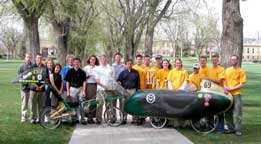Mechanical Engineering Students Take First and Second at the 2003 ASME Human Powered Vehicle Competition
Two of Colorado State's senior mechanical engineering
design teams placed first and second at the 2003 American Society of Mechanical
Engineers Human Powered Vehicle competition, held from April 25 to 27 at the
University of California, Davis. Colorado State students competed in two of
the competition's three categories: the single rider and utility vehicle classes.
Society of Mechanical
Engineers Human Powered Vehicle competition, held from April 25 to 27 at the
University of California, Davis. Colorado State students competed in two of
the competition's three categories: the single rider and utility vehicle classes.
Human Powered Vehicles are aerodynamic, highly engineered "super bikes" that may be used on land, in the water or in the air. Some land-based HPV's have achieved speeds of over 60 mph. Each year, teams comprised of some of the nation's top engineering students compete at the ASME HPV competition in a series of contests judging the vehicles' engineering design, safety, maneuverability and speed.
This year Colorado State's single rider team competed against twenty teams in the West Coast division. The CSU vehicle, Carbon Touch Sexy, placed first in the design event, second in the sprint event and first in the endurance event, winning first place overall. While Colorado State has won the single rider class twice in the past, this is the first year the team has also won the endurance event.
The single rider vehicle has an innovative, monocoque structure, which, unlike a bicycle, does not have a frame made of tubes. The vehicle's aerodynamic shape allowed it to achieve competitive levels of speed. This year's HPV team members were: John Cronin, Justin Maka, Paul Olmsted, Brian Paul, Allison Reinert, Michael Stewart, Julie Trommeter, Nic Vondrak and Lucas Wilson.
The Colorado State utility vehicle team placed second overall, earning first
place in the design event and fourth in the endurance event. The vehicle, named
Iarukas, was designed with one front wheel and two rear wheels. Unlike the rear
wheels of a car, the two rear wheels of the utility vehicle design can lean,
giving the vehicle a mechanism that allows the vehicle to go through a corner
quickly by shifting the center of gravity toward the center of the corner. The
HPV's frame was made of aluminum and the fairings are made of Lexan, a plastic
with excellent strength and weatherability, and a carbon-epoxy composite. The
team members were: Matt Canella, Kyle Chubbuck, Stacy DeWitt, Jeff Elsner, Calvin
Garland, Jennifer Melendez, Nick O'Kane, Ben Quinn and Brianne Wilson.
The mechanical engineering undergraduate program at Colorado State offers a
curriculum that combines classroom learning with engineering practice. During
the senior year, all mechanical engineering students participate in designing
and manufacturing a capstone project judged at a national senior design competition.
Each project is based on a corporate model that provides students significant
opportunities for leadership development and experiential learning. For more
information about Colorado State University's mechanical engineering program,
visit the department's web site at http://www.engr.colostate.edu/me/.
For further details about the Human Powered Vehicle competition, visit the official
ASME HPV web site at: http://www.asme.org/hpv.